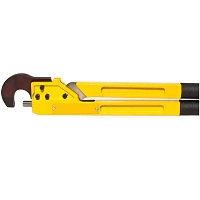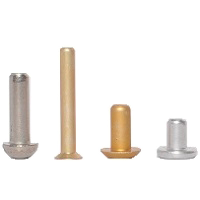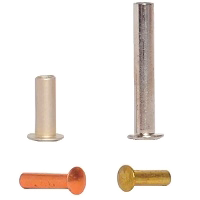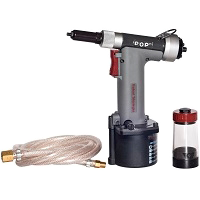What are Rivets and How Do They Work?
Posted by David Byrne Last updated on September 25, 2024 11:33:00 AM
What are Rivets?
Rivets are mechanical fasteners used to join two or more pieces of material together. They are a versatile, strong, and durable fastening solution used across numerous industries. Their ability to create permanent, vibration-resistant joints makes them ideal for applications where security and longevity are essential. From aerospace to construction, rivets provide an efficient and cost-effective solution for fastening materials that ensures structural integrity and long-lasting performance. Whether you need rivets for lightweight applications or heavy-duty assembly, understanding the different types of rivets and their benefits can help you choose the right fastener for your project.
What are the types of rivets?
There are several types of rivets, each designed for specific applications and materials. Here are the main types you can expect to find on our website:
1. Solid Rivets
Solid rivets are the most basic type, consisting of a single shaft and a head. They are deformed with a hammer or rivet gun, creating a strong, permanent joint. Solid rivets are used in applications where strength is paramount, such as in aircraft construction and bridge building.
- Description: Made from a single piece of metal.
- Uses: Heavy-duty applications such as aircraft, shipbuilding, and structural steel.
- Installation: Requires access to both sides of the material; deformed with a hammer or rivet gun.
2. Blind Rivets (Pop Rivets)
Blind rivets, commonly known as pop rivets, are designed for situations where only one side of the material is accessible. These rivets are inserted through a hole and expanded with a special tool to secure the joint. Blind rivets are widely used in automotive and electronic assembly because they are quick and easy to install.
- Description: Can be installed from one side, consists of a rivet body and a mandrel.
- Uses: Applications where access to the back of the material is limited, like automotive and electronics.
- Installation: Inserted into a pre-drilled hole and deformed using a rivet gun, which pulls the mandrel to expand the rivet body and form a second head.
3. Semi-Tubular Rivets
Tubular rivets have a hollow shaft, which makes them lighter and easier to install than solid rivets. They are commonly used in applications like leather goods, electronics, and furniture assembly, where a lighter but effective fastener is needed.
- Description: Have a partial hole in the tail end.
- Uses: Applications requiring less force to install, such as light metal sheets, leather goods, and electronics.
- Installation: A setting tool flares out the hollow portion to form the second head.
Each type of rivet has unique characteristics and advantages, making them suitable for different materials and applications.
Advantages of Using Rivets
- Strength and Durability
Riveted joints are exceptionally strong and can withstand heavy loads and forces, which is why they are commonly used in high-stress environments like aerospace and construction. Rivets do not loosen over time, even in the presence of vibration or shock.
- Permanent Fastening
Once installed, rivets form a permanent joint that cannot be easily removed or tampered with. This makes them suitable for applications where security and longevity are critical.
- Vibration Resistance
Unlike screws or bolts, rivets do not rely on friction to stay in place, meaning they are less likely to loosen over time due to vibration. This makes rivets ideal for transportation and aircraft applications, where consistent performance is essential.
- Cost-Effectiveness
Rivets are typically more cost-effective than other fasteners, such as screws or bolts, both in terms of material cost and installation time. They also require less maintenance over time, making them a long-term cost-saving solution.
- Lightweight
Rivets, especially those made from aluminum or titanium, are significantly lighter than bolts, which is an important factor in industries like aerospace and automotive, where reducing weight is essential for improving efficiency and performance.
Where Are Rivets Used?
Rivets are a versatile fastening solution, and their use spans across numerous industries:
- Aerospace: Rivets are extensively used in the aerospace industry to join the aluminum panels of aircraft. The strength, reliability, and lightweight properties of rivets make them perfect for securing parts without adding unnecessary weight to the structure.
- Construction: Rivets are used in the construction of bridges, buildings, and steel structures. Their ability to form long-lasting, permanent joints ensures the structural integrity of these projects over time.
- Transportation: In automotive manufacturing, rivets are used for assembling body panels, interior components, and other parts where a secure, vibration-resistant fastening solution is needed. Similarly, you will find rivets in trains, buses, trucks, gondolas, cable cars... you name it.
- Electronics: Blind and tubular rivets are often used in electronic devices where space is limited, and only one side of the material is accessible during assembly.
- Furniture and Appliances: Tubular and split rivets are commonly used in furniture and home appliances, offering a quick, reliable way to assemble parts while maintaining aesthetic appeal.
How Are Rivets Installed?
Rivet installation is typically straightforward and requires the appropriate tools depending on the type of rivet used. Solid rivets are usually installed using a hammer or a rivet gun to deform the shaft, while blind rivets require a special pop rivet tool that pulls the mandrel and expands the rivet to create a secure joint.
Installation can be manual or automated, depending on the scale of the project. In large industrial applications like aircraft manufacturing, automated riveting machines are used to install thousands of rivets quickly and accurately.
Removing Rivets: Techniques and Considerations
There are certain occasions when rivets must be removed, whether for repairs, replacements, or disassembly. Understanding the various techniques for rivet removal is crucial for maintaining the integrity of the materials involved and ensuring safety.
Drilling Out Rivets
One of the most common methods for removing rivets is drilling them out. This technique is particularly effective for solid and blind rivets. The process begins by marking the center of the rivet head with a center punch, creating a guide for the drill bit. This step is essential as it helps to keep the drill bit centered, preventing damage to the surrounding material. After putting on your safety gear, a suitable drill bit, typically slightly larger than the rivet's mandrel but smaller than its head, is used to drill through the rivet. Steady pressure and maintaining a perpendicular angle to the surface ensures a clean removal. Once the head is drilled off, the remaining rivet body can be easily pushed out, usually with a punch or pin. This can be a time consuming and delicate process.
Using a Rivet Removal Tool
If you need to remove a large number of rivets, specialized rivet removal tools can be a significant time-saver. These tools are designed to efficiently cut or grind away rivet heads. You just need to position the tool over the rivet head and follow the manufacturer's instructions, which generally involve squeezing handles or pressing a button to activate the cutting mechanism. After the rivet head is removed, the rivet body is pushed out, similar to the drilling method. The primary advantage of using a rivet removal tool is its efficiency and precision, particularly in high-volume or industrial applications.
Grinding Off Rivet Heads
In situations where rivets are particularly stubborn or large (again, think bridges!), an angle grinder can be employed to grind off the rivet heads. This method is effective but requires careful handling to avoid damaging the surrounding material. Wearing appropriate safety gear, such as safety glasses, hearing protection, and gloves, is paramount. The angle grinder is used to carefully grind away the rivet head until it can be pried off with a screwdriver or chisel. Following the removal of the head, the remaining rivet body is pushed out with a punch.
Cutting Rivets
For lightweight or plastic rivets, cutting tools such as rotary cutters or chisels can be used. This method involves cutting off the rivet head and then removing the remaining body. While this method is straightforward, it is typically reserved for less robust rivets due to the limited cutting power of these tools.
Considerations and Safety
Regardless of the method used, safety is top priority. Wearing safety glasses is essential to protect the eyes from metal shavings and debris. Hearing protection is always recommended when using power tools like drills and angle grinders. Ensuring a stable work environment and maintaining control over the tools used can prevent accidents and material damage.
As you can see, rivets are versatile, durable fasteners used across various industries, offering strength, vibration resistance, and cost-effectiveness for permanent joints, with different types suited to specific applications like aerospace, construction, and electronics.







